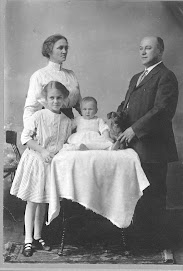

I recently had the opportunity to visit Yad Vashem in Jerusalem. It was a very emotional visit for me. As I walked through the various exhibits and memorials, I became astutely aware that if any of Joseph's family had not emigrated from the Lithuania area prior to 1939 they probably did not survive the war. Approximately 95% of the Jewish people living in the area were killed. I would like to share some of the experiences and history of the exhibits and memorials I visited.
The first exhibit we visited was the Children's Memorial. It was a haunting experience. As you walk through the memorial, a tape is playing stating the name, age and home city of each child known to have died in the Holocaust. It plays continuously while the museum is open. there are approximately 1.5 million names. The memorial was built with a grant from Abe and Edita Spiegel whose son, Uziel, died in one of the camps at the age of five. The stories of how children and infants were separated from their parents is chilling.
As you exit the Children's Memorial there is poignant statue of Janusz Korczak and some of his children, A doctor living in Poland, Janusz helpd found several orphanages. When the Nazis came to Warsaw and moved all of the Jews to the ghetto, Janusz and his orphans were forced to move as well. He worked tirelessly to provide for them, but eventually the children were ordered to the death camps. Janusz refused to leave them and they left for Treblinka together. Witnesses described Korczak and "his children" walking to the train holding hands, carrying knapsacks and marching witih dignity. All of them perished at Treblinka.
Along a pathway to other exhibits, we stopped on the Avenue of the Righteous Among Nations. This special "forest" consists of trees planted in memory of those who made tremendous efforts and sacrifice to save Jews during the Nazi regime. Many of them gave their lives in their effort to save others. We spotted a tree that had been planted in honor of Oscar Schindler.
The main exhibit winds through a large building along a serpentine path traveling through time beginning with the rise of Hitler and the Nazi party through the conquest of countries, the building of ghettos and the deportation of people to "the camps" and concluding with the liberation. Along the way are artifacts from the various cities, ghettos, camps and video testimonies of survivors. As I followed the winding path, I discovered an exhibit for the Kovno ghetto. Kovno is about 85 miles from Taurage.


No comments:
Post a Comment